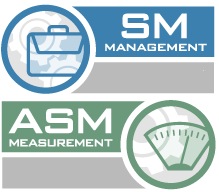SM/ASM 2000 - Software Management & Applications of Software Measurement

PRESENTATIONS
|
Our Experience Using Orthogonal Defect Classification
Orthogonal Defect Classification (ODC) is a method of classifying and analyzing software defects. Using real-life experience, Barbara Hirsh discusses how Motorola successfully implemented ODC within their organization resulting in a framework for building a pervasive and cohesive defect prevention program. Learn the benefits of using ODC from the perspective of the developer, the tester, and the post-release analyst. |
|
|
Performance Evaluation and Measurement of Enterprise Applications
Today's large-scale enterprise applications are all Web-enabled and complex in nature. Many users experience performance problems from day one. Performance evaluation and measurement via extensive testing is the only practical way to raise and address all issues prior to a successful deployment. Learn how to tackle performance and capacity issues with the appropriate testing strategy and scalable infrastructure/architecture. |
|
|
Practical Software Measurement, Performance Based Earned Value
Earned Value can be a software project manager's most effective tool for integrating cost, technical, and schedule management. Learn how to implement Performance Based Earned Value in a practical and cost-effective manner, including specific recommendations and performance metrics for better project planning, meaningful analysis, and improved management control. Real-life examples illustrate both best practices and lessons learned. |
|
|
Practices of High Maturity Organizations
Over the past several years, the Software Engineering Institute has participated in several workshops and site visits with maturity level 4 and 5 software organizations. Mark Paulk discusses the lessons learned from these interactions with high maturity organizations and examines the results of a survey taken to informally test the anecdotal observations about high maturity practices. Explore specific areas of interest, including statistical process, quality control, and product lines/families. |
|
|
Process Improvement Under the 16-Point Plan
In this presentation, Michael Evans provides proven case studies and actual experiences in implementation of a software process improvement program. Learn how the sixteen point plan can be successfully applied to process improvement programs within your organization. Discover which methods and tools can effectively facilitate the implementation process. |
|
|
Relentless Application Development
Discover ways to develop and operate a team that can rapidly produce a tested, documented, and deployed application in less than three months! This presentation identifies important people, processes, and technologies that must be in place to ensure application success. Gain insight into what fails most often on rapid development, and learn what structures must be in place to succeed. |
|
|
Simple Software Defect Categorization for Defect Prevention
Based on her experience with software development organizations at all five levels of the Capability Maturity Model (CMM), Barbara Kolkhorst outlines simple methods for documenting and categorizing defects and how to proceed with analysis for defect prevention. Learn how these simple methods can be implemented within your organization resulting in the prevention of significant numbers of software defects. |
|
|
Software Cost Management with COCOMO II
COCOMO II updates the 1981 Constructive Cost Model (COCOMO) to address the new ways that software is being developed and managed, including non-sequential process models, applications composition, product line management, distributed development and applications, and rapid application development. Barry Boehm summarizes these trends and shows how COCOMO II and its emerging extensions are addressing them. |
|
|
Software Estimating with Functional Metrics
One of the greatest challenges faced by software professionals is the accurate estimation of effort, schedule, and cost for software projects. Learn the technique that has proven to be the most successful in establishing accurate estimates based on quantifying customer requirements and evaluating the development environment using software measurement techniques. Discover ways to use this process to improve estimating accuracy in your software projects. |
|
|
Software Innovation to Benefit the Business: Updating Economic Analysis for Information Technology
This presentation will provide historical background on the limitations of standard economic measurement categories, with suggestions on how to improve measurement for information technology. Explore the limitations of some of the traditional categories used to measure economic progress. Gain insight into why measurement issues are an expected part of economic growth and technological change. |
|


